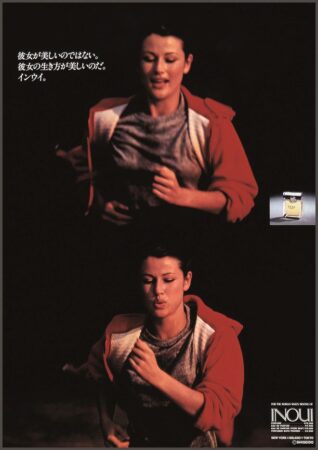
Shiseido Inouï Museum #7 ad
From Shiseido: “Inoui was released with the vivid message: “It’s not her that’s beautiful; it’s how she lives her life that’s beautiful.” For this product Shiseido paired with an American design company to come up with an unprecedented design, one well suited to women of refined international sensibilities and particular about performance and usability. The slim, sleek containers were designed to target the contemporary career woman.” ~ text describing the Inouï line of beauty products, it is also equally applicable to the perfume.
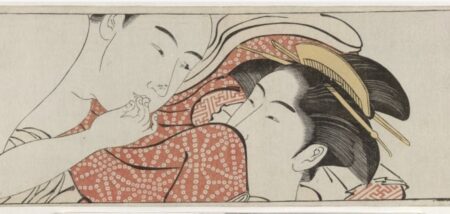
handscroll for the sleeve, British Museum – Shunga from the Tenmai era
Before Serge Lutens assumed the helm of Shiseido as its creative director, there were multiple fragrances this Japanese-based house released, and so many of them memorable. I believe, at that time, it had always been a challenge for Shiseido to bridge an audience with often opposing aesthetics regarding fragrance. Some American perfumers such as Dawn Spencer Hurwitz and Maria McElroy have been sensitive (and responsive) to these preferences by creating fragrances which tend to be appealing to Asian sensibilities. Maria’s aesthetic has always favored a Japanese subtlety; her devotion to these nuances continue to be part and parcel of her life. Dawn has composed perfumes which began as a line of delicate scents created for the Japanese market, named DAWN (Pretty & Pink, Sweet Dreams, Butterfly Nectar, Peony, Special Formula X) – of which Sweet Dreams and Special Formula X remain readily available today; others may be specially ordered, from what I glean. From a societal viewpoint, circa 1976 was an era of great change and political/social restlessness.
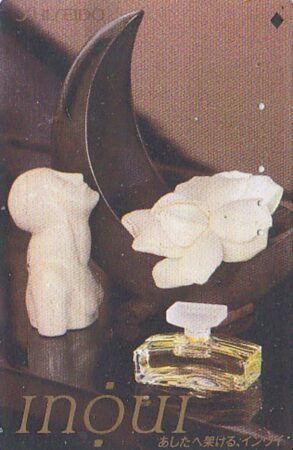
Inouï ad
It is clear from popular advertising that women’s perfumes employed imagery and text reflecting a ‘liberated’ individual: one who was capable of juggling career and home life – all the while smelling (and looking) fabulous. It is helpful to note that during the ‘70s, Japan was very aware of the burgeoning worldwide market for their excellent craftsmanship – and America’s embracing their automotive and watchmaking expertise is a good example. In the beauty arena, Shiseido’s color palette more closely mirrored Caucasian complexions and paler skin – and the newer fragrances aimed to tempt Western tastes while retaining a sophisticated delicacy which was culturally favored at home. Patently not an easy task.
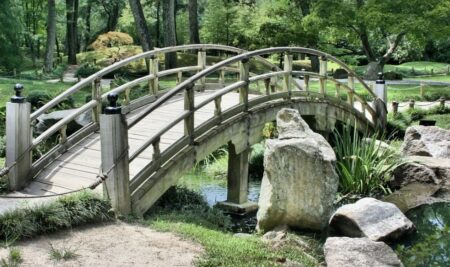
Pixabay Japanese garden by JamesDeMers
Shiseido Inouï, a perfume which blows warm and cool – is a subtle, unprecedented (inouï translates as extraordinary, unprecedented, unheard-of) green meeting of East-Meets-West chypre. Anyone who has experienced the delight of sampling a well-preserved bottle will attest to its powerful seduction-via-understatement; my sense is that it wasn’t quite in step with the times when it was released. When I scan the fragrances released during 1976, the lion’s share of them are very potent, possessing considerable sillage which travels far – unlike the ethereal wafting which was part of Inouï’s inimitable charm. A mere glance at its aromatic components hints at its complexity and mutable nature: the melding of juniper, pine needles, galbanum, and thyme, for example. It would have been so easy to employ these in a ham-fisted manner, a drowning of the senses in verdant overdose – but that is not the case, thankfully. Peach and lemon appear remarkably tender, a lovely counterbalance to the green bouquet; a modicum of freesia and haunting jasmine are the only florals – just enough to spark interest and further the perfume’s complexity. Inouï’s base is a harmonious marriage of cedar pencil shavings (divine!), the compelling aridity of myrrh, and ever-so-masterful brush-stokes of musk and civet, so clever that you would be hard-pressed to parse them. At any given moment, these fragrant personae weave in and out – and this ongoing movement is enchanting without subjecting the wearer to high-decibel volume. At times, I perceive a costus-like aroma – one which contributes to Shiseido mysticism. If a chypre might be described as spiritual, then Shiseido Inouï comes closer than many other chypres I’ve smelt over the years (and that’s a great many years). It is a perfume which haunts and changes shape in a blink of the eye.
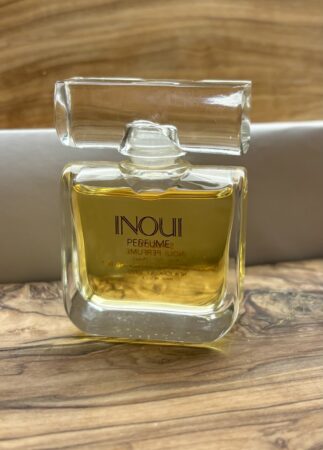
Ida’s flacon of Shiseido Inouï’
I included the opening mission statement from Shiseido to illustrate their astute summation of the beauty/fragrance market in the 1970s. Unfortunately, Inouï’s run was brief: composed in 1976, it was discontinued early on in the 1980s. One does well not to infer that this discontinuation evinces any flaw pertaining to the fragrance itself. In an era of fairly heady higher volume scents, the ethereal and eloquent Inouï likely became lost in the aromatic shuffle: after all, 1976 was the year that heavy-hitting fragrances were extremely popular. Some emblematic examples are First for Van Cleef & Arpels by Jean-Claude Ellena, Halston Z-14 by Vincent Marcello and Max Gavarry, Payot’s Pavlova, and Caron’s Yatagan, composed by Vincent Marcello. To be truthful, this bold trend in fragrance would continue to gain momentum to this very day.
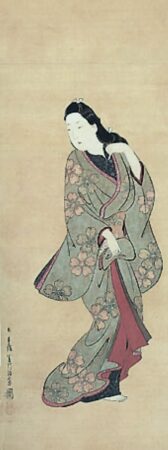
Hishikawa Moronobu, Beauty Looking Back, c. second half of 17th C., courtesy of Collection Sumisho, Tokyo
There is always room for variety. We require it in order to more fully appreciate that which we experience. To this end, I would highly recommend seeking out a sample of Inouï for yourselves, if for no other reason than expanding your olfactory palette and discovering something precious, rare, and unique. I was fortunate to locate a pristine flacon of the parfum online for a reasonable price (let’s simply say that it set me back a great deal less than many popular fragrances readily available these days). Like many scents, it’s only a ‘safe’ buy if you are chypre-mad, interested in perfume history, or are curious about singular green fragrances. Inouï was a blind buy (yes, I’m fallible too) which I’ve not regretted one whit – it is worth every penny.
Notes: galbanum, peach, lemon, juniper, green accord, pine needles, freesia, thyme, jasmine, cedarwood, myrrh, musk, civet
Perfume is from my personal collection. My nose is my own…
~ Ida Meister, Deputy and Natural Perfumery Editor
Follow us on Instagram @cafleurebonofficial @idameister
This is our Privacy Policy
